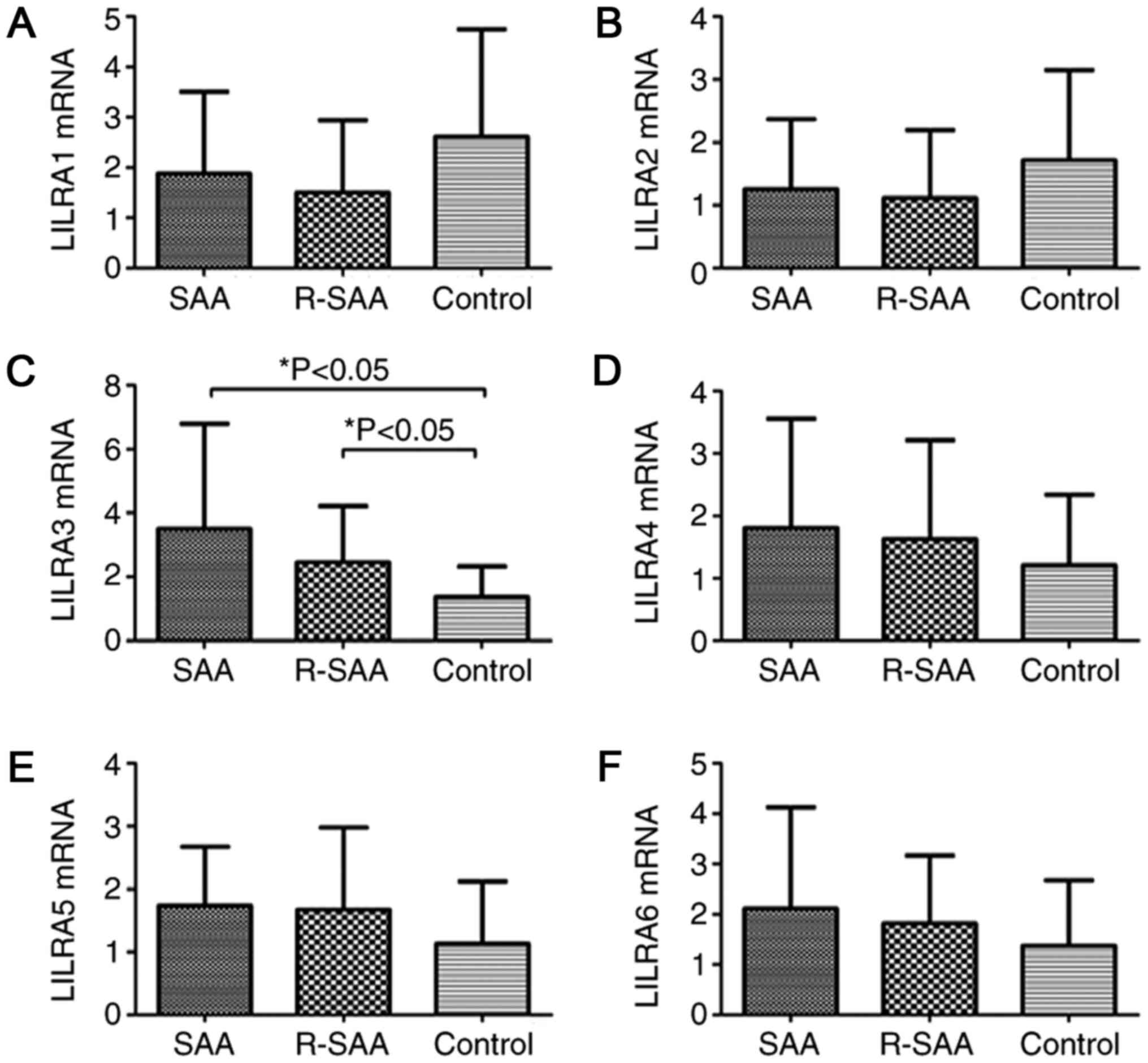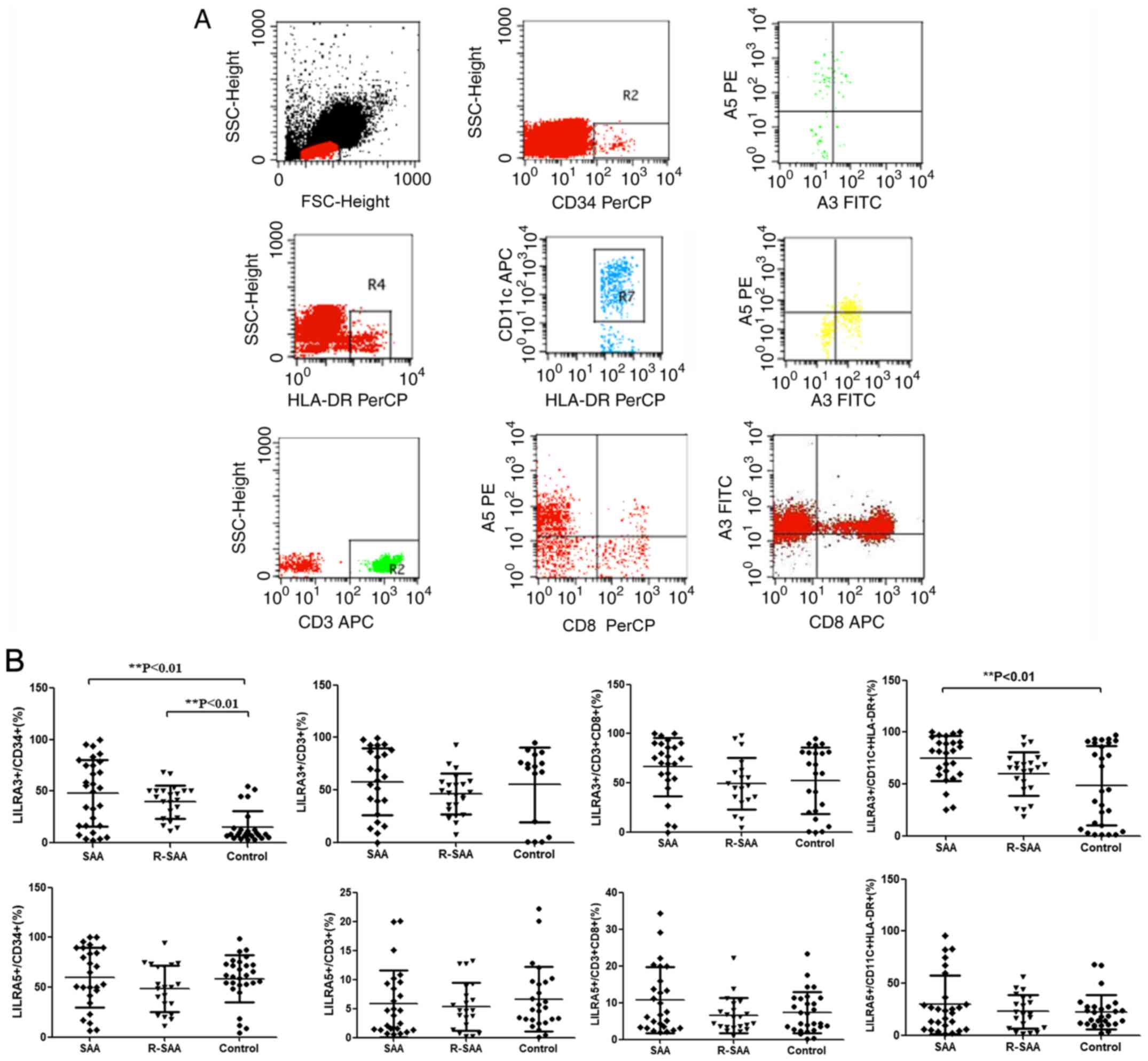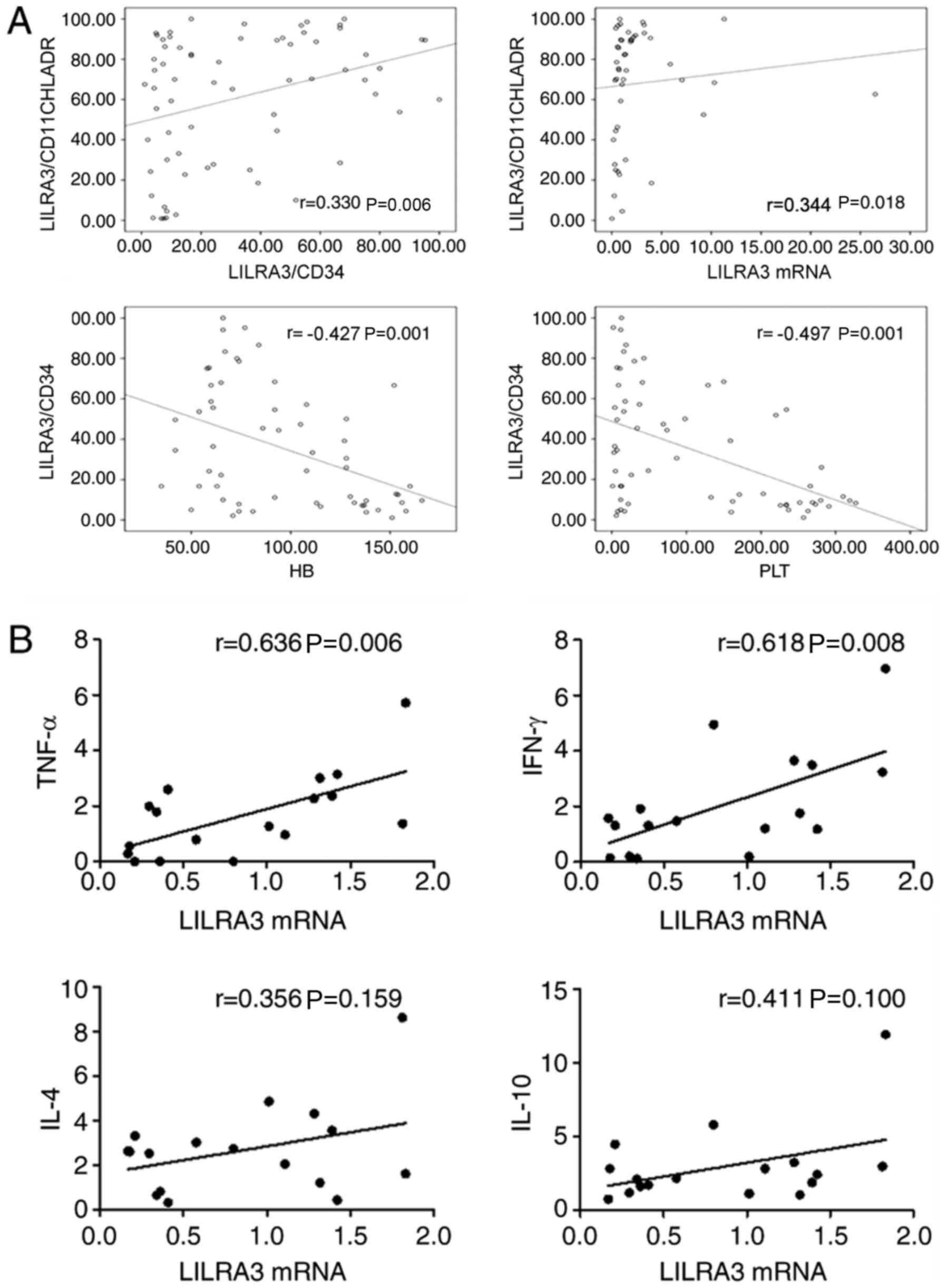|
1
|
Young NS: Aplastic anemia. N Engl J Med.
379:1643–1656. 2018.PubMed/NCBI View Article : Google Scholar
|
|
2
|
Young NS: The etiology of acquired
aplastic anemia. Rev Clin Exp Hematol. 4:236–259. 2000.
|
|
3
|
Miano M and Dufour C: The diagnosis and
treatment of aplastic anemia: A review. Int J Hematol. 101:527–535.
2015.PubMed/NCBI View Article : Google Scholar
|
|
4
|
Zeng Y and Katsanis E: The complex
pathophysiology of acquired aplastic anaemia. Clin Exp Immunol.
180:361–370. 2015.PubMed/NCBI View Article : Google Scholar
|
|
5
|
Zonghong S, Meifeng T, Huaquan W, Limin X,
Jun W, Rong F, Hong L and Yuhong W: Circulating myeloid dendritic
cells are increased in individuals with severe aplastic anemia. Int
J Hematol. 93:156–162. 2011.PubMed/NCBI View Article : Google Scholar
|
|
6
|
Liu C, Sheng W, Fu R, Wang H, Li L, Liu H
and Shao Z: Differential expression of the proteome of myeloid
dendritic cells in severe aplastic anemia. Cell Immunol.
285:141–148. 2013.PubMed/NCBI View Article : Google Scholar
|
|
7
|
Qi W, Fu R, Wang H, Liu C, Ren Y, Shao Y
and Shao Z: Comparative proteomic analysis of CD34(+) cells in bone
marrow between severe aplastic anemia and normal control. Cell
Immunol. 304-305:9–15. 2016.PubMed/NCBI View Article : Google Scholar
|
|
8
|
Norman PJ, Carey BS, Stephens HAF and
Vaughan RW: DNA sequence variation and molecular genotyping of
natural killer leukocyte immunoglobulin-like receptor, LILRA3.
Immunogenetics. 55:165–171. 2003.PubMed/NCBI View Article : Google Scholar
|
|
9
|
Brown D, Trowsdale J and Allen R: The LILR
family: Modulators of innate and adaptive immune pathways in health
and disease. Tissue Antigens. 64:215–225. 2004.PubMed/NCBI View Article : Google Scholar
|
|
10
|
Hirayasu K and Arase H: Functional and
genetic diversity of leukocyte immunoglobulin-like receptor and
implication for disease associations. J Hum Genet. 60:703–708.
2015.PubMed/NCBI View Article : Google Scholar
|
|
11
|
Jones DC, Kosmoliaptsis V, Apps R, Lapaque
N, Smith I, Kono A, Chang C, Boyle LH, Taylor CJ, Trowsdale J and
Allen RL: HLA class I allelic sequence and conformation regulate
leukocyte Ig-like receptor binding. J Immunol. 186:2990–2997.
2011.PubMed/NCBI View Article : Google Scholar
|
|
12
|
An H, Lim C, Guillemin GJ, Vollmer-Conna
U, Rawlinson W, Bryant K and Tedla N: Serum leukocyte
immunoglobulin-like receptor A3 (LILRA3) is increased in patients
with multiple sclerosis and is a strong independent indicator of
disease severity; 6.7kbp LILRA3 gene deletion is not associated
with diseases susceptibility. PLoS One. 11(e0149200)2016.PubMed/NCBI View Article : Google Scholar
|
|
13
|
Low HZ, Ahrenstorf G, Pommerenke C,
Habermann N, Schughart K, Ordóñez D, Stripecke R, Wilk E and Witte
T: TLR8 regulation of LILRA3 in monocytes is abrogated in human
immunodeficiency virus infection and correlates to CD4 counts and
virus loads. Retrovirology. 13(15)2016.PubMed/NCBI View Article : Google Scholar
|
|
14
|
Sugahara-Tobinai A, Inui M, Metoki T,
Watanabe Y, Onuma R, Takai T and Kumaki S: Augmented ILT3/LILRB4
expression of peripheral blood antibody secreting cells in the
acute phase of kawasaki disease. Pediatr Infect Dis J. 38:431–438.
2019.PubMed/NCBI View Article : Google Scholar
|
|
15
|
Debebe BJ, Boelen L and Lee JC: IAVI
Protocol C Investigators. Sanders EJ, Anzala O, Kamali A, Kaleebu
P, Karita E, Kilembe W, et al: Identifying the immune interactions
underlying HLA class I disease associations. Elife.
9(e54558)2020.PubMed/NCBI View Article : Google Scholar
|
|
16
|
Camitta BM, Storb R and Thomas ED:
Aplastic anemia (second of two parts): Pathogenesis, diagnosis,
treatment, and prognosis. N Engl J Med. 306:712–718.
1982.PubMed/NCBI View Article : Google Scholar
|
|
17
|
Camitta BM, Storb R and Thomas ED:
Aplastic anemia (first of two parts): Pathogenesis, diagnosis,
treatment, and prognosis. N Engl J Med. 306:645–652.
1982.PubMed/NCBI View Article : Google Scholar
|
|
18
|
Di Bona E, Rodeghiero F, Bruno B, Gabbas
A, Foa P, Locasciulli A, Rosanelli C, Camba L, Saracco P, Lippi A,
et al: Rabbit antithymocyte globulin (r-ATG) plus cyclosporine and
granulocyte colony stimulating factor is an effective treatment for
aplastic anaemia patients unresponsive to a first course of
intensive immunosuppressive therapy. Gruppo italiano trapianto di
midollo osseo (GITMO). Br J Haematol. 107:330–334. 1999.PubMed/NCBI View Article : Google Scholar
|
|
19
|
Livak KJ and Schmittgen TD: Analysis of
relative gene expression data using real-time quantitative PCR and
the 2(-Delta Delta C(T)) method. Method. 25:402–408.
2001.PubMed/NCBI View Article : Google Scholar
|
|
20
|
Liu C and Shao Z: Aplastic anemia in
China. J Transl Int Med. 6:134–137. 2018.PubMed/NCBI View Article : Google Scholar
|
|
21
|
Liu C, Sun Y and Shao Z: Current concepts
of the pathogenesis of aplastic anemia. Curr Pharm Des. 25:236–241.
2019.PubMed/NCBI View Article : Google Scholar
|
|
22
|
Chen T, Zhang T, Liu C, Wang C, Ding S,
Shao Z and Fu R: NK cells suppress CD8+ T cell immunity
via NKG2D in severe aplastic anemia. Cell Immunol. 335:6–14.
2019.PubMed/NCBI View Article : Google Scholar
|
|
23
|
Liu B, Shao Y, Liu Z, Liu C, Zhang T and
Fu R: Bone marrow plasma cytokine signature profiles in severe
aplastic anemia. Biomed Res Int. 2020(8789275)2020.PubMed/NCBI View Article : Google Scholar
|
|
24
|
Liu C, Zheng M, Wang T, Jiang H, Fu R,
Wang H, Ding K, Zhou Q and Shao Z: PKM2 is required to activate
myeloid dendritic cells from patients with severe aplastic anemia.
Oxid Med Cell Longev. 2018(1364165)2018.PubMed/NCBI View Article : Google Scholar
|
|
25
|
Steinbrink K, Mahnke K, Grabbe S, Enk AH
and Jonuleit H: Myeloid dendritic cell: From sentinel of immunity
to key player of peripheral tolerance. Hum Immunol. 70:289–293.
2009.PubMed/NCBI View Article : Google Scholar
|
|
26
|
Qi W, Yan L, Liu C, Fu R, Wang H and Shao
Z: Abnormal histone acetylation of CD8+ T cells in
patients with severe aplastic anemia. Int J Hematol. 104:540–547.
2016.PubMed/NCBI View Article : Google Scholar
|
|
27
|
Park JE, Brand DD, Rosloniec EF, Yi AK,
Stuart JM, Kang AH and Myers LK: Leukocyte-associated
immunoglobulin-like receptor 1 inhibits T-cell signaling by
decreasing protein phosphorylation in the T-cell signaling pathway.
J Biol Chem. 295:2239–2247. 2020.PubMed/NCBI View Article : Google Scholar
|
|
28
|
An H, Chandra V, Piraino B, Borges L,
Geczy C, McNeil HP, Bryant K and Tedla N: Soluble LILRA3, a
potential natural antiinflammatory protein, is increased in
patients with rheumatoid arthritis and is tightly regulated by
interleukin 10, tumor necrosis factor-alpha, and interferon-gamma.
J Rheumatol. 37:1596–1606. 2010.PubMed/NCBI View Article : Google Scholar
|
|
29
|
Du Y, Sun F, Zhou M, Wu X, Sun W, Jiang Y,
Cheng Q, Chen X, Wu H and Xue J: The expression and clinical
significance of different forms of LILRA3 in systemic lupus
erythematosus. Clin Rheumatol. 38:3099–3107. 2019.PubMed/NCBI View Article : Google Scholar
|
|
30
|
Low HZ, Reuter S, Topperwien M,
Dankenbrink N, Peest D, Kabalak G, Stripecke R, Schmidt RE,
Matthias T and Witte T: Association of the LILRA3 deletion with
B-NHL and functional characterization of the immunostimulatory
molecule. PLoS One. 8(e81360)2013.PubMed/NCBI View Article : Google Scholar
|
|
31
|
Nezos A, Evangelopoulos ME and Mavragani
CP: Genetic contributors and soluble mediators in prediction of
autoimmune comorbidity. J Autoimmun. 104(102317)2019.PubMed/NCBI View Article : Google Scholar
|













